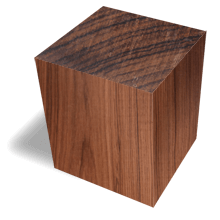
Honduran Rosewood
Honduran Rosewood, scientifically Dalbergia stevensonii, is a tropical hardwood from the Fabaceae family, native to Central America, primarily found in southern Belize, eastern Guatemala, and northern Honduras. It grows in swampy, seasonally flooded forests near rivers and lagoons, reaching heights of 50–100 feet with trunk diameters of 2–3 feet, often with a straight bole that makes it ideal for lumber production.
The heartwood of Honduran Rosewood is a rich, dark brown with hints of purple or red, often displaying darker black or violet streaks that create a striking contrast. Freshly cut, it may show brighter reddish tones that deepen with age and exposure to light. The sapwood is a pale yellowish-white, sharply distinct from the heartwood. The grain is typically straight to slightly interlocked, with a fine, even texture and a high natural lustre that gives it a polished, glossy appearance when finished.
Honduran Rosewood has a density of around 900–1,050 kg/m³, making it a very hard, heavy, and durable wood with excellent stability once seasoned. It’s highly resistant to decay, moisture, and insects, thanks to its natural oils, which also contribute to its smooth, waxy feel. These oils can make gluing challenging—wiping with a solvent like alcohol before bonding is recommended—and may affect some finishes, though oil-based or wax finishes work well. The wood machines and turns beautifully, but its hardness can dull tools, and its fine dust may cause irritation, potentially leading to allergic reactions like dermatitis in some individuals.
When worked, Honduran Rosewood emits a sweet, floral aroma, characteristic of many rosewoods, which can linger in the finished piece. It’s renowned for its acoustic properties, offering a warm, resonant tone with excellent clarity, making it a top choice for musical instruments like marimba bars, xylophones, and guitar fingerboards. In the UK, it’s also used for high-end furniture, cabinetry, veneer, and small turned objects like knife handles or pen blanks, where its rich colour and grain can be showcased.
Honduran Rosewood is expensive and increasingly rare due to overharvesting. It’s listed on CITES Appendix II, and Dalbergia stevensonii is considered vulnerable by the IUCN due to habitat loss and exploitation for the exotic wood trade. In Belize, annual export quotas (e.g., 1,500 m³ of sawn wood in 2025) are strictly regulated to prevent further decline. In the UK, it’s often used sparingly in bespoke craftsmanship, where its tonal qualities and beauty justify the cost, but sustainable sourcing or alternatives like other rosewoods are increasingly considered to reduce pressure on wild populations.
